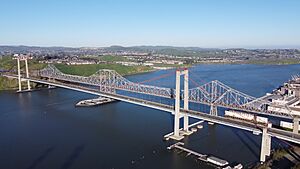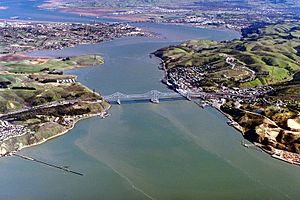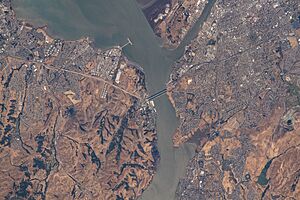Carquinez Bridge facts for kids
Quick facts for kids Carquinez Bridge |
|
|---|---|

The Carquinez Bridge in 2022: (from closest to furthest) a 2003 suspension bridge and the 1958 cantilever bridge
|
|
| Coordinates | 38°03′39″N 122°13′33″W / 38.0608°N 122.2257°W |
| Carries |
|
| Crosses | Carquinez Strait |
| Locale | Crockett and Vallejo, California, U.S. |
| Official name | Alfred Zampa Memorial Bridge (suspension bridge only) |
| Other name(s) | Zampa Bridge, Vallejo Bridge |
| Owner | State of California |
| Maintained by | California Department of Transportation and the Bay Area Toll Authority |
| ID number | 23 0015L (1927 span) 23 0015R (1958 span) 28 0352L (2003 span) |
| Characteristics | |
| Design | Cantilever bridge (eastbound) Suspension bridge (westbound) |
| Total length | 3,465 feet (1,056 m) or 0.66 miles (1.06 km) (suspension bridge), 3,300 feet (1,000 m) (cantilever bridge) |
| Width | 84 feet (26 m) (suspension deck), 52 feet (16 m) (cantilever deck) |
| Height | 410 feet (120 m) (suspension tower) |
| Longest span | 2,387 feet (728 m) (suspension span) |
| Clearance below | 148 feet (45 m) (suspension bridge), 140 feet (43 m) (cantilever bridge) |
| History | |
| Opened | May 21, 1927 (original span) November 25, 1958 (eastbound) November 11, 2003 (westbound) |
| Closed | September 4, 2007 (original span) |
| Statistics | |
| Toll |
|
The Carquinez Bridge is actually two bridges that stand side-by-side. They cross the Carquinez Strait at the top end of San Francisco Bay. These bridges are an important part of Interstate 80. They connect the towns of Crockett and Vallejo in California, United States.
The first Carquinez Bridge was a single cantilever bridge built in 1927. It was a key route between San Francisco and Sacramento. As more cars used the road, a second, similar bridge was finished in 1958 to handle the extra traffic.
Later, engineers found that the 1927 bridge was not safe in an earthquake. This led to building a new suspension bridge to replace it. This new bridge opened in 2003. It is officially called the Alfred Zampa Memorial Bridge. It was named after Al Zampa, an iron worker who helped build many bridges in the San Francisco Bay Area. Today, the Alfred Zampa Memorial Bridge carries traffic heading from Vallejo to Crockett. The 1958 cantilever bridge carries traffic going the other way.
Contents
Bridge History and Design
Before the bridges, people crossed the Carquinez Strait using ferries. These boat services started in the mid-1800s. A car ferry service began in 1913 near where the bridges are now.
The First Bridge (1927–2007)
The first steel cantilever bridge was opened on May 21, 1927. It was designed by Robinson & Steinman. Before this bridge, ferries were the only way to cross the Carquinez Strait. Building the bridge cost $8 million. It was the first major bridge crossing in the San Francisco Bay area. It was also a big step forward in bridge building at the time.
After it was built, this bridge became part of the Lincoln Highway. This historic road crossed the country. Before the bridge, drivers had to take a much longer route around the Delta. This route went south through Stockton and over a mountain pass. Building a bridge across the Carquinez Strait was thought to be too hard and expensive for many years. But once the bridge was finished, driving from Sacramento to the East Bay became much faster. The Carquinez Bridge offered a direct path from the Central Valley to the Bay Area. Drivers no longer needed to load their cars onto ferries. The Lincoln Highway was then changed to go through Davis and Vallejo, across the Carquinez Bridge. This route later became Interstate 80.
After the 1989 Loma Prieta earthquake, engineers found that the old 1927 bridge was not safe in an earthquake. It could not be fixed. So, the decision was made to replace it with a new suspension bridge. The old 1927 bridge was used for eastbound traffic for a short time. This was while the 1958 bridge was being made stronger and safer. The old 1927 cantilever bridge was taken apart. This was completed on September 4, 2007, about three years after its replacement opened.
The Parallel Bridge (1958)
A second bridge was built right next to the 1927 bridge. It cost $38 million. This new bridge opened in November 1958. For a few months, it carried all the traffic. Then, after new ramps were built, the 1927 bridge (which had three lanes) carried traffic going west. The new 1958 bridge (with four lanes) carried traffic going east.
Alfred Zampa Memorial Bridge (2003 Replacement)

A new suspension bridge was built west of the two older bridges. It cost $240 million. This bridge was built by a team of companies.
This new bridge was named the Alfred Zampa Memorial Bridge. It honors Al Zampa, an ironworker who helped build many bridges in the San Francisco Bay Area. This includes the Golden Gate Bridge and the first Carquinez Bridge. The bridge was officially opened on November 8, 2003. Traffic started using it on November 11, 2003.
The new suspension bridge is about 0.66 miles long. It has a path for people walking and riding bikes. This path is part of a larger bike trail that will eventually go all around the Bay Area. The materials for this new bridge came from all over the world. For example, steel parts came from California and Japan. Wires for the main cables came from England and Canada.
Bridge Tolls
Tolls are only collected from traffic going east. You pay the toll after crossing from Crockett, at the toll plaza on the Vallejo side. Even though the 2003 Alfred Zampa Memorial Bridge is newer, there is no toll for traffic going that way. This continues the rule from the old 1927 bridge.
Since 2020, you can only pay tolls electronically. Drivers can use a FasTrak device or pay by license plate. Cash is not accepted. The toll for cars is $8.00. During busy weekday hours (5:00 am to 10:00 am, and 3:00 pm to 7:00 pm), carpool vehicles with three or more people, clean air vehicles, or motorcycles can pay a lower toll of $4.00. They must use FasTrak and the special carpool lane. If you don't have FasTrak or a license plate account, you must pay online within 48 hours after crossing.
How Tolls Have Changed
The first 1927 bridge had a toll. But the state bought the bridge in 1940, and tolls were removed five years later. In 1926, the toll was $0.60 per car plus $0.10 per passenger. This was lowered over time. By 1942, it was $0.25 per car before being removed in 1945.
Tolls were brought back in 1958 when the second bridge was finished. It was set at $0.25 again. Over the years, the toll slowly increased. It went up to $0.35 in 1970 and $0.40 in 1978.
In 1988, voters approved a plan to make the basic toll $1.00 on seven state-owned bridges, including the Carquinez Bridge. In 1998, an extra $1.00 was added to help pay for earthquake safety upgrades. This made the toll $2.00. Voters approved more money for transportation projects in 2004, raising the toll to $3.00. Another dollar was added in 2007 to help pay for the new Bay Bridge section, making the toll $4.00.
The Metropolitan Transportation Commission (MTC) manages these toll funds. A lot of this money goes to public transportation improvements.
Because more money was needed for earthquake safety, the toll went up again in July 2010 to $5.00.
In June 2018, Bay Area voters approved another plan to raise tolls. This was to fund $4.5 billion worth of transportation improvements. The toll for cars on the Carquinez Bridge increased to $6.00 on January 1, 2019. It then went up to $7.00 on January 1, 2022. As of January 1, 2025, the toll is $8.00.
In September 2019, the MTC decided to remove toll takers and switch all seven state-owned bridges to electronic tolling. This was because most drivers were already using FasTrak, and it would help traffic flow better. On March 20, 2020, this change happened faster due to the COVID-19 pandemic. All seven bridges became cashless. New systems were put in place to make them permanently cashless by early 2021. In April 2022, plans were announced to remove all unused toll booths. This will create a system where drivers don't have to slow down to pay tolls.
See also
- Benicia–Martinez Bridge
- List of bridges documented by the Historic American Engineering Record in California




